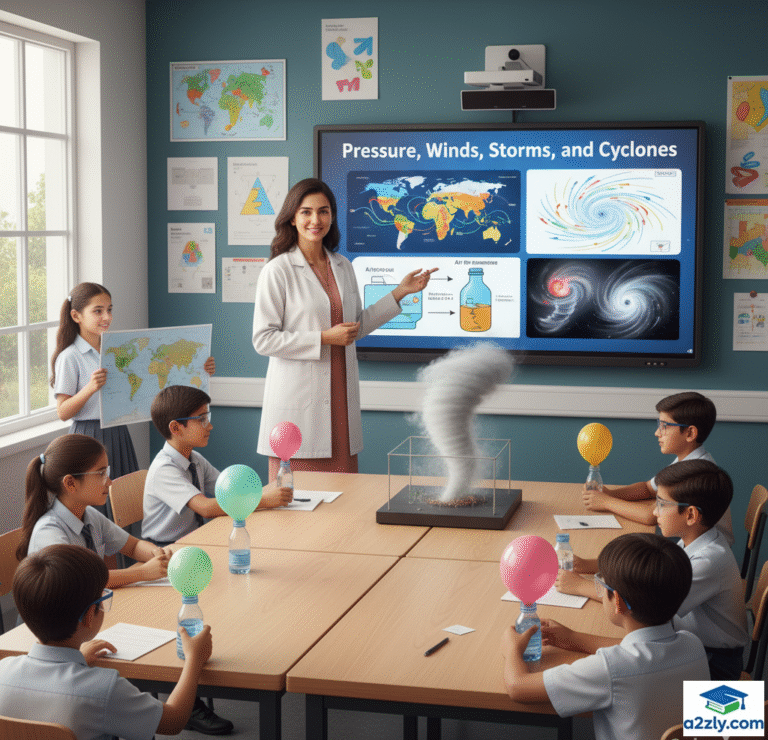🧭 Chapter Overview
Air is not just empty space — it’s a powerful force that can move oceans, shake trees, and even cause massive cyclones.
This chapter, “Pressure, Winds, Storms, and Cyclones,” explores how air pressure and temperature differences cause wind, how winds lead to storms, and how nature’s most powerful systems — cyclones — form and behave.
By the end of this chapter, you’ll understand the science behind weather, how to predict wind directions, and how humans can prepare for and survive cyclones using knowledge and technology.
Table of Contents
🎯 Learning Objectives (NEP 2025 Competency Table)
| Competency | Learning Outcome | NEP Skill |
|---|---|---|
| Conceptual Understanding | Explain air pressure and factors affecting it | Analytical Thinking |
| Inquiry-Based Learning | Demonstrate pressure experiments | Scientific Inquiry |
| Application | Relate pressure differences to wind formation | Real-Life Connection |
| Environmental Awareness | Describe cyclone causes & safety | Sustainability Awareness |
| Values Integration | Learn human responsibility in disasters | Citizenship & Ethics |
🌬️ 6.1 What Is Air Pressure?
Air has weight — it presses on everything around us.
The force exerted by air per unit area is called air pressure. Pressure=ForceArea\text{Pressure} = \frac{\text{Force}}{\text{Area}}Pressure=AreaForce
🌡️ Key Points:
- Air exerts pressure in all directions.
- Pressure decreases with height (less air above you).
- Temperature affects pressure — warm air is lighter, cool air is heavier.
🧪 Activity: Pressure in Action
Aim: To show that air exerts pressure.
Materials: Glass, water, and cardboard.
Procedure:
- Fill glass ¾ with water.
- Cover with cardboard and invert.
- The water doesn’t fall!
Explanation:
Air pressure acting upward balances the weight of water.
💡 Invisible air can hold up visible water — that’s the power of pressure!
🌪️ 6.2 How Are Winds Formed?
Winds are caused by differences in air pressure.
Air moves from a high-pressure area to a low-pressure area.
☀️ Heat and Wind
When the Sun heats Earth’s surface unevenly:
- Warm air rises (low pressure).
- Cool air sinks (high pressure).
- Air movement between these zones creates wind.
🌊 Land Breeze and Sea Breeze
| Type | Time | Direction | Explanation |
|---|---|---|---|
| Sea Breeze | Day | Sea → Land | Land heats faster; warm air rises over land; cool sea air flows in. |
| Land Breeze | Night | Land → Sea | Land cools faster; warm air rises over sea; cool land air replaces it. |
🌅 That gentle beach wind you feel? It’s nature balancing temperatures.
🧭 Global Wind Patterns
Earth’s rotation and sunlight create permanent wind systems:
- Trade Winds – Blow from east to west near equator.
- Westerlies – Blow from west to east in temperate regions.
- Polar Winds – Blow from poles toward lower latitudes.
🌍 These winds influence weather, rainfall, and ocean currents.
🌫️ 6.3 Air Pressure and Weather
Air pressure helps meteorologists predict weather.
| Air Pressure | Air Movement | Weather |
|---|---|---|
| Low Pressure | Warm air rising | Cloudy, stormy |
| High Pressure | Cool air sinking | Clear, dry |
🌦️ A sudden drop in air pressure often means a storm is coming.
⚡ 6.4 What Are Storms?
A storm is a violent disturbance in the atmosphere caused by rapid air movement due to pressure differences.
🌩️ Types of Storms
| Type | Description | Example |
|---|---|---|
| Thunderstorm | Heavy rain + thunder + lightning | Summer storms |
| Dust Storm | Strong winds carrying sand | Deserts |
| Snowstorm | Heavy snow + wind | Mountains |
| Cyclone / Hurricane / Typhoon | Powerful rotating storm over oceans | Coastal regions |
🌈 Thunderstorms and Lightning
Lightning is caused by electric discharge between clouds or between cloud and ground.
⚠️ Safety Tips During Lightning:
- Don’t stand under trees.
- Stay indoors and unplug electronics.
- Avoid open fields and water.
- Sit on the floor (not metal objects).
⚡ Lightning travels faster than sound — that’s why you see the flash before hearing thunder.
🌊 6.5 Cyclones – Nature’s Giant Whirlwinds
A cyclone is a huge rotating storm system that forms over warm ocean water.
🌪️ Conditions for Cyclone Formation
- Warm ocean water (≥ 27°C)
- High humidity
- Low air pressure
- Earth’s rotation (Coriolis effect)
🌀 Structure of a Cyclone
| Part | Description |
|---|---|
| Eye | Calm center of the cyclone |
| Eye Wall | Surrounding area with strongest winds |
| Rain Bands | Spiraling clouds causing rain & floods |
🌍 Cyclone Naming & Regions
| Region | Local Name | Example |
|---|---|---|
| Indian Ocean | Cyclone | Cyclone Amphan |
| Atlantic Ocean | Hurricane | Hurricane Katrina |
| Pacific Ocean | Typhoon | Typhoon Haiyan |
🧠 All three are the same weather phenomenon — just different regional names!
🚨 Effects of Cyclones
🌧️ Heavy Rainfall → Floods
💨 Strong Winds → Damage to houses, crops, and power lines
🌊 Storm Surges → Coastal flooding
🛡️ Precautions During Cyclones
| Before | During | After |
|---|---|---|
| Listen to weather forecasts | Stay indoors | Avoid flooded areas |
| Store food & water | Disconnect power | Drink clean water |
| Pack emergency kit | Stay away from windows | Help neighbors |
📻 India’s IMD (Indian Meteorological Department) monitors cyclones and issues early warnings through satellites and radar.
🌎 6.6 India’s Major Cyclones
| Cyclone | Year | Impacted States | Impact |
|---|---|---|---|
| Odisha Super Cyclone | 1999 | Odisha | 10,000+ lives lost |
| Cyclone Amphan | 2020 | Bengal, Odisha | Severe floods |
| Cyclone Yaas | 2021 | Bengal, Jharkhand | Widespread damage |
| Cyclone Tauktae | 2021 | Gujarat, Maharashtra | Coastal destruction |
🇮🇳 Disaster preparedness has reduced cyclone-related loss by 70% since 2000.
🌱 6.7 Disaster Preparedness and Mitigation
To prevent loss during storms and cyclones, India follows a 3-step safety plan:
1️⃣ Prediction & Warning Systems:
- Satellites and Doppler Radars track cyclone movement.
- Alerts shared through IMD and NDMA.
2️⃣ Preparedness:
- Evacuate coastal areas early.
- Build cyclone shelters.
- Educate communities.
3️⃣ Response & Recovery:
- Rescue operations by NDRF.
- Relief camps, medical aid, rebuilding support.
🧠 HOTS (Higher Order Thinking Skills)
- Why do cyclones form only over warm seas and not land?
- How can air pressure predict a storm?
- Why is a tornado smaller but more intense than a cyclone?
- How does deforestation increase cyclone impact?
- How do satellites help in reducing cyclone damage?
⚙️ NEP COMPETENCY FRAMEWORK
| Domain | NEP Skill | Activity |
|---|---|---|
| Conceptual | Explain pressure & cyclone formation | Diagram + explanation |
| Analytical | Analyze weather data | Graph reading |
| Practical | Demonstrate pressure activity | Glass-card experiment |
| Creative | Design awareness poster | “Stay Safe During Cyclone” campaign |
| Ethical | Promote disaster management | School mock drill |
💡 Memory Booster Box
🔹 Air exerts pressure in all directions
🔹 Wind moves from high to low pressure
🔹 Warm air = light; cool air = heavy
🔹 Cyclones form over warm oceans
🔹 IMD tracks and names cyclones
🔹 Safety = Awareness + Preparedness
⚠️ Exam Alert Box
📍 Define: Air pressure, Cyclone, Frictional force of air
📍 Differentiate: Land breeze vs Sea breeze
📍 Explain: Conditions for cyclone formation
📍 Diagram: Structure of a cyclone
📍 Value Question: Role of humans in disaster management
📘 Quick Recap
✅ Air pressure changes cause winds
✅ Uneven heating → Pressure differences → Wind movement
✅ Low pressure = storms and rainfall
✅ Cyclones form over warm oceans
✅ Preparedness reduces disaster loss
🔗 INTERNAL & EXTERNAL LINKS
Internal Links (A2ZLY):
- Chapter 5 – Exploring Forces Notes 2025
- Class 8 Science All Chapters Smart Notes 2025
- NEP 2025 Smart Learning Hub | A2ZLY
External Links:

